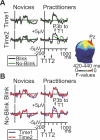Mental training affects distribution of limited brain resources
- PMID: 17488185
- PMCID: PMC1865565
- DOI: 10.1371/journal.pbio.0050138
Mental training affects distribution of limited brain resources
Abstract
The information processing capacity of the human mind is limited, as is evidenced by the so-called "attentional-blink" deficit: When two targets (T1 and T2) embedded in a rapid stream of events are presented in close temporal proximity, the second target is often not seen. This deficit is believed to result from competition between the two targets for limited attentional resources. Here we show, using performance in an attentional-blink task and scalp-recorded brain potentials, that meditation, or mental training, affects the distribution of limited brain resources. Three months of intensive mental training resulted in a smaller attentional blink and reduced brain-resource allocation to the first target, as reflected by a smaller T1-elicited P3b, a brain-potential index of resource allocation. Furthermore, those individuals that showed the largest decrease in brain-resource allocation to T1 generally showed the greatest reduction in attentional-blink size. These observations provide novel support for the view that the ability to accurately identify T2 depends upon the efficient deployment of resources to T1. The results also demonstrate that mental training can result in increased control over the distribution of limited brain resources. Our study supports the idea that plasticity in brain and mental function exists throughout life and illustrates the usefulness of systematic mental training in the study of the human mind.
Conflict of interest statement
Figures





Comment in
-
Learning to pay attention.PLoS Biol. 2007 Jun;5(6):e166. doi: 10.1371/journal.pbio.0050166. Epub 2007 May 8. PLoS Biol. 2007. PMID: 20076676 Free PMC article. No abstract available.
References
-
- Marois R, Ivanoff J. Capacity limits of information processing in the brain. Trends Cogn Sci. 2005;9:296–305. - PubMed
-
- Raymond JE, Shapiro KL, Arnell KM. Temporary suppression of visual processing in an RSVP task: An attentional blink? J Exp Psychol Hum Percept Perform. 1992;18:849–860. - PubMed
-
- Ward R, Duncan J, Shapiro K. The slow time-course of visual attention. Cogn Psychol. 1996;30:79–109. - PubMed
-
- Shapiro KL, Arnell KA, Raymond JE. The attentional blink. Trends Cogn Sci. 1997;1:291–296. - PubMed
-
- Martens S, Munneke J, Smid H, Johnson A. Quick minds don't blink: Electrophysiological correlates of individual differences in attentional selection. J Cogn Neurosci. 2006;18:1423–1438. - PubMed
Publication types
MeSH terms
Grants and funding
LinkOut - more resources
Full Text Sources

